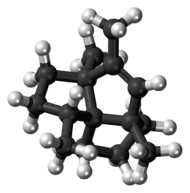Isocomene
Appearance

| |

| |
| Names | |
|---|---|
| IUPAC name
(3aS,5aS,8aR)-1,3a,4,5a-Tetramethyl-1,2,3,3a,5a,6,7,8-octahydrocyclopenta[c]pentalene
| |
| Identifiers | |
3D model (JSmol)
|
|
| ChemSpider | |
PubChem CID
|
|
CompTox Dashboard (EPA)
|
|
| |
| |
| Properties | |
| C15H24 | |
| Molar mass | 204.357 g·mol−1 |
Except where otherwise noted, data are given for materials in their standard state (at 25 °C [77 °F], 100 kPa).
| |
Isocomene is a naturally occurring sesquiterpene first isolated from the rayless golden rod Isocoma wrightii, from which it derives its name. Its unusual structure consisting of three fused cyclopentane rings was first described by Zalkow et al. in 1977. The first total synthesis of isocomene was published by M.C. Pirrung in 1979.[1] The key steps are a photocatalyzed intramolecular [2 + 2] cycloaddition reaction followed by a rearrangement reaction which forms three contiguous chiral centers.[2]
References
- ^ Michael C. Pirrung (1979). "Total synthesis of (±)-isocomene". Journal of the American Chemical Society. 101 (23): 7130–7131. doi:10.1021/ja00517a087.
- ^ Nicolaou, K. C.; E. J. Sorensen (1996). Classics in Total Synthesis. Weinheim, Germany: VCH. p. 221. ISBN 3-527-29284-5.
